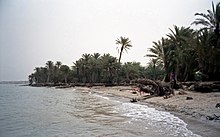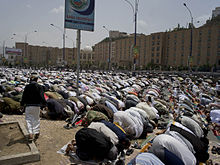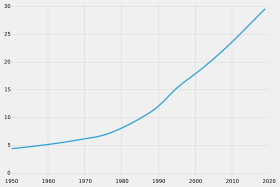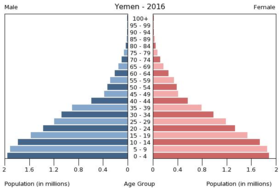Yemen
![]()
The title of this article is ambiguous. For other meanings, see Yemen (disambiguation).
Template:Infobox State/Maintenance/TRANSCRIPTION
Template:Infobox State/Maintenance/NAME-German
The Republic of Yemen (officially Yemeni Republic, Arabic الجمهورية اليمنية, DMG al-Ǧumhūriyya al-Yamaniyya) is a state in the Near East, in the south of the Arabian Peninsula. The state of Yemen is now defunct as a cohesive, sovereign entity (as of 2020) due to civil war and its ongoing political-social upheavals.
Yemen borders Saudi Arabia to the north, Oman to the east, the Gulf of Aden and the Arabian Sea to the south, and the Red Sea to the west. The states of Djibouti and Eritrea lie about 20 and 30 kilometres respectively across the Red Sea. The coastline is 2400 kilometers long; the internal borders are 1746 kilometers long. Yemen also includes the 3814 km² archipelago of Socotra and numerous smaller islands in the Bab al-Mandab in the Red Sea and the Arabian Sea.
In 1990, the two former states of North Yemen (capital Sanaa) and the People's Democratic Republic of Yemen (southeast, capital Aden) united to form the present state.
Since 2013, there has been a civil war in which foreign powers intervened. In this conflict, the Huthi militias succeeded in capturing the capital Sanaa and large parts of the country. On March 25, 2015, Saudi Arabia, with the military participation of eight other states, launched a military intervention called Storm of Determination in support of the central government led by President Hadi and the head of government, Chalid Bahah. The conflict in Yemen is assessed as a proxy war between Saudi Arabia and Iran.
In the course of the war, cholera broke out in Yemen in 2016; more than 1.4 million people fell ill and more than 2800 died. According to the UN, 80 percent of the population is dependent on humanitarian aid as a result of the war.
Yemen ranks last on the Global Innovation Index, which assessed the innovative capacity of a total of 128 countries in 2016. Yemen is also last in the 2016 Global Gender Gap Report, which measures gender equality in a country. Yemen leads the Fragile States Index with first place.
Geography
→ Main article: Geography of Yemen
Nature area
Yemen can be divided into three major landscapes:
The gently rising coastal plain, which is between 30 and 60 kilometres wide, is divided by thrusting mountain flanks, especially in the southwest. In some places there is evidence of former volcanism; for example, Aden, the former capital of the People's Democratic Republic of Yemen (South Yemen), lies in a double crater. The plain on the west coast, the Tihama, is dominated by sand and gravel plains.
Toward the interior, the rugged Rand Mountains rise steeply, several times exceeding 3,000 meters in height in the west. To the southwest of the capital Sanaa rises the Jabal an-Nabi Shuʿaib, at 3760 meters the highest mountain in the country.
The mountains are followed by highlands, with average altitudes of 2000 to 2500 meters. It is crisscrossed by wadis; the best known is the Wadi Hadramaut, which runs parallel to the southern coast. Toward the northeast, the highlands slope down in steps to the central Arabian sand desert of ar-Rubʿ al-Chali.
Climate
The islands and the coastal plain are hot and humid and have very little precipitation overall (Aden: January average 25 °C, June average 33 °C, 40 mm annual precipitation). Humidity is very high here, ranging from 60 to 85 percent all year round. Precipitation is extremely low throughout the year, usually only between 25 mm and 150 mm, which is equivalent to 5 to 15 rainy days a year. The winter half of the year is very warm, with 19 to 23 °C at night and 28 to 31 °C during the day. Summers often become unbearably hot due to the high humidity as well as daytime temperatures of 34 to 38 °C and more. In addition, the night values usually do not drop below 26 °C, often there are even periods of tropical nights with consistently over 30 °C. The only, but very rare cooling in the summer brings occasional foothills of the Indian monsoon, which sometimes make it with light rain showers to the southeast coast of Yemen (on the west coast they are completely absent). However, this is contrasted by occasional heat waves of 40°C and above. A phenomenon on the coasts is the not infrequent occurrence of morning fog, which is soon lifted by the strong rays of the sun. On the west coast it is largely winter fog, on the southeast coast summer fog.
The mountains occupy more than one third of the country and are characterized by the main mountain range of Al-Sarat. This mountainous region knows many, very densely populated basins, which lie throughout at an altitude of 1500 to 2500 meters. The climate here is very mild for the region. Winters are dry and marked by high temperature fluctuations: at night it often cools down to almost freezing point (0 to 4 °C), while during the day the warming rays of the sun provide pleasant values (22 to 24 °C). The summer is moderately humid, which is particularly beneficial for agriculture. The highest rainfall is recorded in the Yemeni mountains. In some areas it rains up to 50 days a year (200 to 700 mm), with the main rainfall occurring between March and August. On rainy days it is somewhat cooler, otherwise daytime temperatures rise to 26 to 30 °C, but at night it remains at rather subdued values of 9 to 13 °C. The humidity is medium throughout the year and levels off at around 40 percent.
The climate in the highlands is largely dry throughout the year (5 to 25 rainy days). Winters are mild but subject to large temperature fluctuations (23 to 28 °C during the day, 0 to 6 °C at night), summers are relatively hot with daytime values around 36 °C, followed by cool nights (10 to 16 °C). On the desert fringes, values of 45 °C are not uncommon. The air is rather dry all year round (25 to 45 percent).
flora and fauna
Vegetation
Yemen lies on the border between the Holarctic and Palaeotropic plant kingdoms. It harbours a steppe landscape only in the coastal plain. Towards the mountains, the vegetation corresponds to that of a thornbush savannah. In the mountains, which reach heights of over 3000 metres, an afroalpine, frost-tolerant plant cover is found. Only in the extreme east does the vegetation gradually change from a semi-desert to a real desert; only remnants of near-natural plant communities remain as a result of thousands of years of cultivation (logging, grazing, agriculture).
Flora
Yemen is home to an abundance of endemic plant species. Small mangrove areas occur along the Red Sea coast. Acacias largely determine the landscape. Depending on altitude and rainfall - from drier (low altitudes) to wetter (high altitudes) - the following zonation occurs: Acacia tortilis, Acacia mellifera (honey acacia), Acacia asak, A. etbaica. A. ehrenbergiana and A. oerfota (from urfut, the "stinking one") are common in wadis in the uplands and in the Tihama. Yemen was famous in ancient times for its "fragrant shrubs" (Frankincense Road). Frankincense (Boswellia sacra) on the high plateau of Jol in the south, myrrh bush (Commiphora erythrea, C. myrrha) and balsam bush (C. opobalsamum) grow in the humid, western mountain slopes. The imposing flowering desert rose (Adenium obesum) is considered the national tree of the country. Large strangler figs (Ficus sycomorus) and tamarinds (Tamarindus indica) grow in deeply cut wadis. From the group of millets, foxtail millet (Pennisetum) grows more in the lowlands of the Tihama and panicum miliaceum (Panicum miliaceum) grows more in the mountainous areas. Wheat and barley grow at higher altitudes. Coffee occurs at altitudes roughly between 1000 and 2000 m, with the lower limit formed by heat and the upper limit by frost. The ecologically much less demanding qat, the well-known drug shrub in Yemen, has already largely displaced coffee. Henna bushes grow at medium altitudes with sufficient water supply. Cultivated date palms (Phoenix dactylifera) occur along river courses with high groundwater levels. Okra, peppers and broad beans are important vegetable crops. Tropical fruits such as papaya and bananas are cultivated in the lowlands, while apples and pears grow in the mountains. Melons are found at almost all altitudes.
Wildlife
The abundance of reptile species is normal for an arid region. The location on the southwestern zone of the Arabian Peninsula has produced various endemics that live only in Yemen. For example, the tree-climbing Yemen monitor (Varanus jemense) was not scientifically described until 1988. Until 1985, the existence of this species was unknown to science. The Yemen chameleon (Chamaeleo calyptratus) and the Yemen agama (Acanthocerus adramitanus) are other colourful endemic representatives. Birdlife is also abundant due to the country's location and topography. Goliath herons (Ardea goliath) on the coasts, spectacular species such as hammerhead (Scopus umbretta), Abyssinian bluebirds and various nectar birds on wadis of the mountain tihama, steppe eagles (Aquila nipalensis orientalis) and serpent eagles (Circaetus gallicus), various harriers (Circus) in the mountainous areas, and griffon vultures anywhere in the country where large carrion attracts them are conspicuous bird representatives.
Wild mammals have become rare due to extreme hunting. Mountain animals such as the Nubian ibex and steppe animals such as the oryx antelope are already extinct or threatened with extinction. Baboons still exist in inaccessible areas of the Jabal Burrah. Some leopards are also present in Yemen. Smaller populations of hyenas are also said to still exist. The Gulf of Aden is rich in fish, especially sardines, tuna and sharks.

Red Sea beach near Chaucha
.jpg)
Jebel Haraz
Population
Yemen's population is growing rapidly, increasing from 17.8 million to 28.2 million between 2000 and 2017, and is on average very young; almost half are 15 years old or younger. This results in a poor ratio of working to non-working population (100:477) and places a heavy burden on public infrastructure and the labor market: the population aged 15-24 was estimated at nearly 4 million in 2000 and more than 5 million in 2010; 10 million are expected by 2050. The urban population is growing by almost 5% per year. Youth unemployment in 2005/2006 was estimated at 29%; 57% of all unemployed were youth. Due to the high birth rate, the population will grow to almost 50 million by 2050 (UN estimate), which will further strain economic and political stability. Yemen's limited resources can hardly support the growing population.
According to the High Commissioner for Refugees (UNHCR), there were about 250,000 refugees in Yemen's urban areas in July 2015. Most of them came from Somalia. At least 58 refugees from Somalia drowned off the coast of Yemen on September 5, 2005, while another 155 went missing after being forced to swim ashore several kilometers off the coast, in an escape organized by gangs of smugglers. Further accidents also occurred in the following months, according to the UNHCR.
Population development
| Year | Population |
| 1950 | 04.402.000 |
| 1960 | 05.172.000 |
| 1970 | 06.194.000 |
| 1980 | 08.120.000 |
| 1990 | 12.057.000 |
| 2000 | 17.875.000 |
| 2010 | 23.607.000 |
| 2019 | 29.162.000 |
Source: UN
Ethnicities
Around 97 percent of the inhabitants are Arabs. The population of Tihama is partly of black African origin: the Achdam population group is said to be of Ethiopian descent. The Achdam remain a discriminated "caste" in Yemeni society to this day, which causes problems. About one percent of the population are Pakistani or Muslim Indian migrant workers, and about two percent are ethnic Somalis, many of whom have lived in the country for some time.
Yemen hosted approximately 110,000 refugees from Somalia in 2007. In 2007 alone, 30,000 people fled Somalia for Yemen via the Gulf of Aden, with an estimated 1400 drowned or disappeared during the crossing. Furthermore, the conflict in the north of the country has turned 35,000 people into refugees in their own country (internally displaced persons). The treatment of refugees in Yemen is described as inadequate.
The official language is High Arabic. Bedouin dialects and southern Arabic languages are also used. Knowledge of foreign languages suitable for communication is very rare, even in the south; the foreign language most often taught in schools is English, which is found mainly in the south, which was formerly colonized by Great Britain.
See also: Wayla
Religion
→ Main articles: History of Judaism in Yemen and Al-Qaeda in Yemen.
Almost all inhabitants of Yemen are Muslims. The largest proportion is made up of Sunnis, the majority of whom are followers of the Shafiite school of law. A large minority (30-45% of the population) belongs to the Shiite Zaidites. A small minority of Ismailis live in northern Yemen, as well as a diaspora of a few Jews (about 300). 4500 religious schools have been closed and foreign students of the institutions have been expelled from the country. The number of Christians is estimated at a few hundred to a few thousand.
The military has repeatedly fought religiously motivated armed insurgencies, most recently in the northern governorate of Sa'da since 2004. The al-Haq party, whose leaders are said to have had ties with the insurgents, was banned in 2007. The government is attempting to curb extremism by monitoring sermons in mosques and observing the activities of Islamic organizations. However, Yemen is home to several large Salafist religious schools, such as the "Dar al-Hadith" in Dammaj near Saadah.
Yemen's constitution declares Islam to be the state religion and requires that the president of the republic should fulfill his duties as a Muslim. At the same time, the constitution grants freedom of belief. This is only partially implemented by the government: Missionary work and proselytism among Muslims are prohibited, special permission is required to establish non-Islamic houses of worship, and non-Muslims are allowed to vote in elections but are not allowed to stand for election. Public schools offer only Islamic religious instruction. Public consumption of alcohol is punishable under Islamic law in Yemen. Homosexual acts are also prohibited and can be punished by death.

Sanaa
.jpg)
Men from Yemen

Distribution of ethnoreligious groups in Yemen with Shiite (green) and Sunni (yellow) Arabs (2002)

Population development in millions of inhabitants

Yemen has an extremely young population
Questions and Answers
Q: What is the official name of Yemen?
A: The official name of Yemen is the Republic of Yemen.
Q: Where is Yemen located?
A: Yemen is located in the Middle East, on the south side of the Arabian Peninsula. It borders Saudi Arabia and Oman to the north and east, and has a coastline along the Guardafui Channel, Gulf of Aden, and Red Sea to its south and west.
Q: What island does Yemen own?
A: Yemen owns Socotra Island which lies 217 miles off the coast of East Africa.
Q: What is another name for people or things from Yemen?
A: People or things from Yemen are referred to as Yemeni.
Q: What was ancient Arabia called by Romans?
A: Ancient Arabia was known as Arabia Felix ("Happy Arabia" in Latin) by Romans because it was so beautiful and powerful.
Q: When did Islam first come to be practiced in Yemen? A: Islam first came to be practiced in Yemen during the 700s when many Yemeni people were among some of the first followers of this new religion.
Q: Who ruled Al-Andalus (Muslim Spain) for centuries? A: Men whose ancestors came from present-day Yemen ruled Al-Andalus (Muslim Spain) for centuries.
Search within the encyclopedia